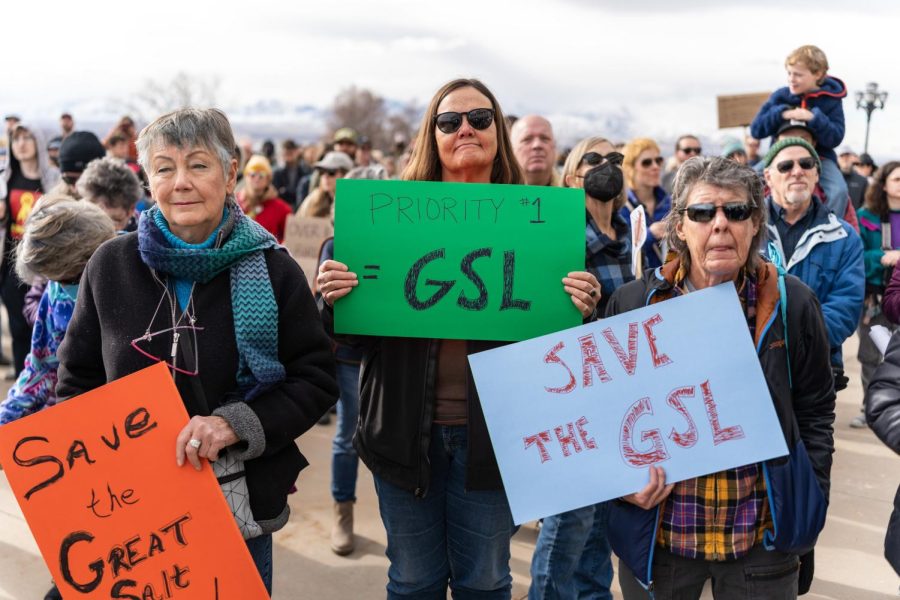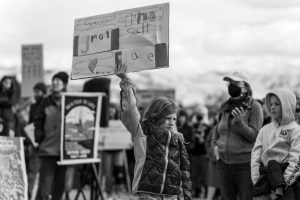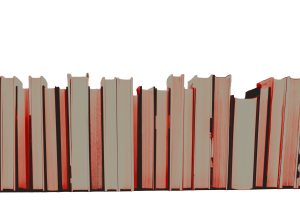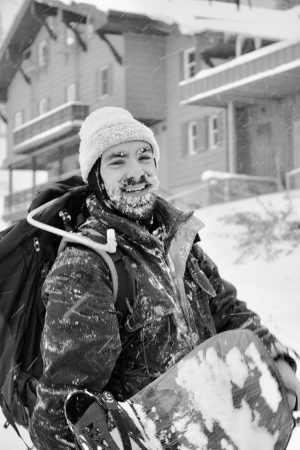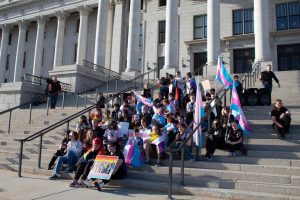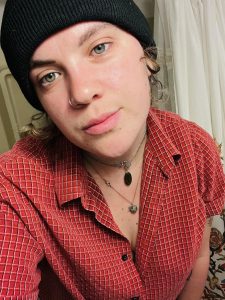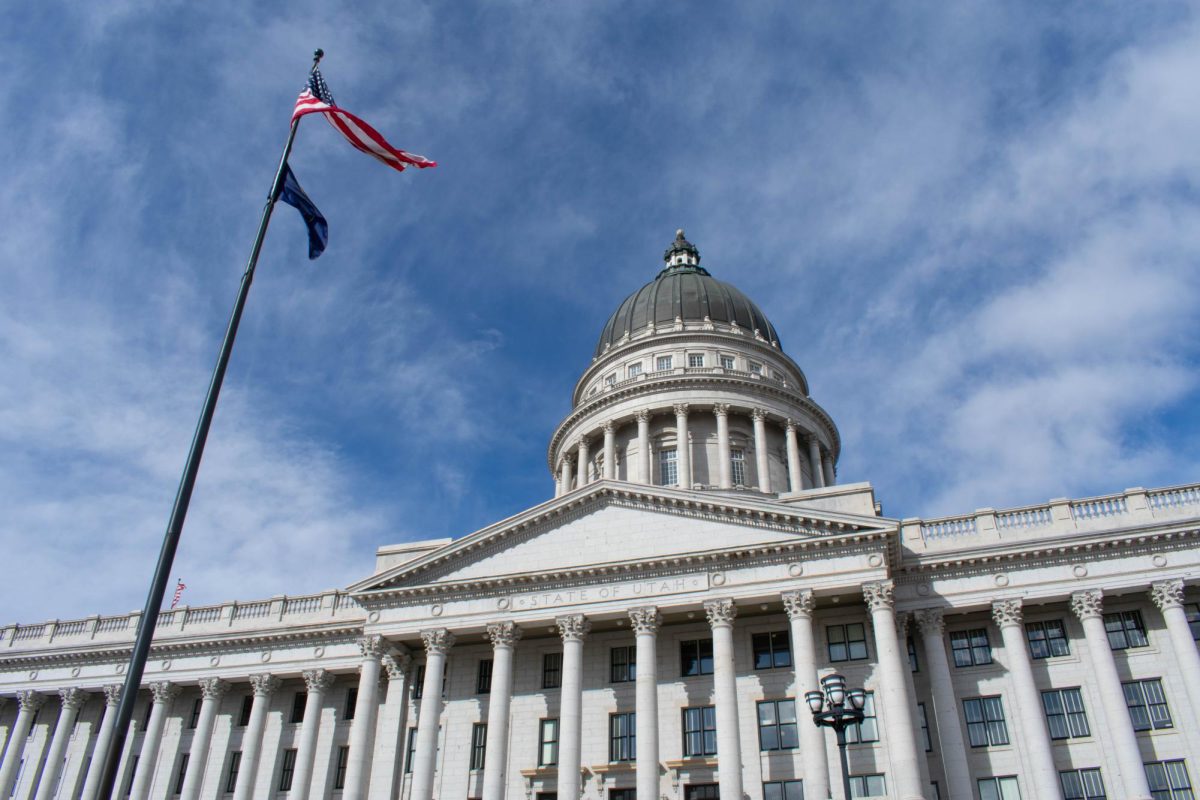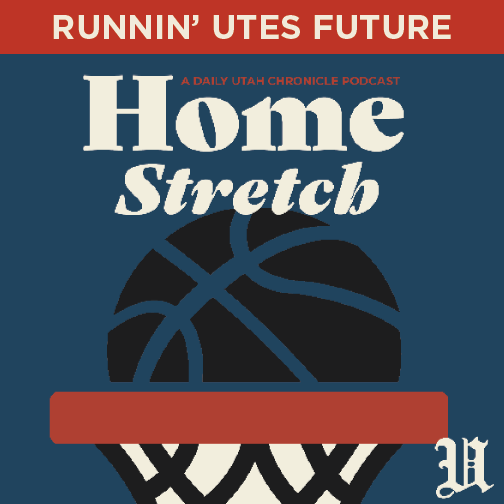‘Water is life’: Rally to Save Great Salt Lake Emphasizes Immediate Action
Participants at Rally To Save Our Great Salt Lake at the Utah State Capitol in Salt Lake City on Saturday, Jan. 14, 2023. (Photo by Xiangyao “Axe” Tang | The Daily Utah Chronicle)
January 14, 2023
The Great Salt Lake is drying up, and the people are crying out. Often turning their bodies to face the lake, 12 speakers joined hundreds of community members at a rally to “Save Our Great Salt Lake” on the steps of the Utah State Capitol on Saturday, Jan. 14.
The rally began with a song called “Lake Home.” Attendees sang “We are all water, and we’re all running dry, but we’re rising up to Great Salt Lake’s Cry.”
Listening to the Lake
Since 1850, the lake’s average natural level has dropped by 19 feet, according to a BYU College of Life Sciences report. Unsustainable water use has contributed to habitat destruction, toxic dust and changing salinity levels “incompatible with the lake’s food webs.”
“The lake’s drop has accelerated since 2020, with an average deficit of 1.2 million acre-feet per year,” the report reads. “If this loss rate continues, the lake as we know it is on track to disappear in five years.”
The shrinking of the lake has both dire consequences for wildlife and humans.
“The health of the lake will always parallel the health of people,” said Darren Parry, the former Chairman of the Northwestern Band of the Shoshone Nation, at the rally.
Parry told the crowd: “Water is life.”
“We were taught at an early age that everything that surrounds us has life and has a spirit so that we can live in harmony with ourselves,” Parry said. “And our plants and animals and water, kinfolk. We have always believed that the earth is our mother. That the people and the earth gives us life. Ours is a story about a people who have been using the powers of the Great Salt Lake to survive.”
Parry said it is essential to govern with future generations in mind.
“We can no longer sacrifice the future for the sake of short-term profits … ,” Parry said. “As an Indigenous leader, we are asking for a seat at the table.”
Katie Newburn, the education and outreach director for the Friends of Great Salt Lake, said the first stages of ecosystem collapse are already visible.
“We’ve used Great Salt Lake as a credit line allowing us to live beyond the means of our natural water supply,” Newburn said. “Now the lake is calling that debt due.”
Friends urged the state to create a long-term target lake level and a short-term emergency release plan.
“Emergency conservation measures are a small price to pay for our collective interest in preserving the ecosystem on which we and tens of millions of migratory birds depend,” Newburn said. “We know what needs to be done, and be done now, not a year from now. There will be no tomorrow for the lake if we don’t act today.”
When Luis Miranda, a racial and climate justice organizer, came to Salt Lake from Guatemala 20 years ago, he wanted to do two things: touch snow and swim in the Great Salt Lake. He was able to do both.
“Well, now our Great Salt Lake is dying,” Miranda said. “And she’s not dying on her own. She is dying because of the spineless politics that we have here in the state of Utah.”
Throughout his speech, he asked the audience “What are we going to do?” and the audience responded, “Stand up, fight back.”
“My colleague, the Black environmental activist Hop Hopkins says racism is killing the planet,” Miranda said. “I believe that racism is also killing the Great Salt Lake. And you’re wondering how, right? Well, Hop says that you can’t have climate change without sacrifice zones, that you cannot have climate change without disposable people and you cannot have disposable people without racism.”
As the lake continues to dry up, Miranda said communities of color would be the first to face its repercussions, breathing in toxic dust.
“I beg you, don’t let today be the only activist action you do for the Great Salt Lake and racial justice,” he said. “Let today be your recommitment to sustain the fight.”
Ashley Finley, birthkeeper and community activist, encouraged the crowd to care for their kin and remember their DNA.
“Remember that before your ancestors brought violence and greed and stepped foot here, you had other ones who loved and cared for the land,” Finley said. “Remember what this place was before that violence and greed. Remember what it could be again. Remember our interconnectedness. Remember the beauty of what it means to be part of a healthy and thriving ecosystem.”
Carl Moore, cofounder of SLC Air Protectors, told the audience to use whatever privilege they have to talk about these problems and educate others.
“Educate your people, educate your kids, because that’s really what’s gonna happen is when we educate our kids, and people like me, my generation we go away or whatever, and this next generation comes and they come in a way of love and respect,” Moore said.
Nan Seymour, poet and founder of River Writing, read two poems to the lake, and then spoke about a vigil that was kept by a community of writers for 47 days on Antelope Island during the 2022 legislative session.
“We stayed there day and night to be a constant presence really to make an offering of our presence and we’re doing it again this session,” Seymour said.
Joan Entwistle, a volunteer activist with the Utah Chapter of the Sierra Club, which partnered with Save Our Great Salt Lake for the rally, said environmental groups have been aware of the problem with the lake for years, and legislators are just recently starting to pay attention.
“I’m afraid that in five years, we’re gonna see people fleeing from Utah because who wants to be poisoned by all the arsenic that’s floating around?” she said.
Miranda told the Chronicle saving the Great Salt Lake will take both new policies and a transformation of the movement itself.
“That in fact we can’t be doing this movement without taking into account the leadership and the voices again, of Indigenous people,” he said. “And also the people that are experiencing, frontline, the impact of what’s happening.”


